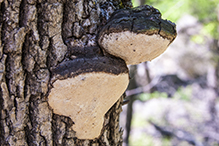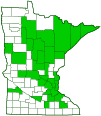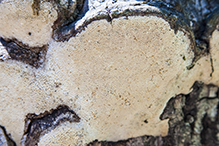Willow Bracket
(Phellinus igniarius)
Conservation • Description • Habitat • Ecology • Distribution • Taxonomy
Conservation Status |
|
|||||||
| IUCN Red List | not listed |
|||||||
| NatureServe | not listed |
|||||||
| Minnesota | not listed |
|||||||
Description |
||
Willow Bracket is common and widespread fungus. It occurs in Europe, Asia, and North America, and has few scattered records south of the equator. It is common in Minnesota. It causes white trunk rot on hardwood trees. It turns the wood into a soft, white, spongy mass. It infects twenty-one genera of hardwoods. It is most common on willow, but it also infects birch, poplar, alder, apple, ash, black walnut, buckthorn, cherry, hazel, ironwood, maple, and mountain ash. The fruiting body (conk) is a 2″ to 8″ wide, ¾″ to 4¾″ thick polypore. It is hoof-shaped, rounded and curved downward on top, flat or slightly angled upward below. There is no stalk. The upper surface is brown and hairy when young, soon becoming gray and hairless. Older specimens are black and often cracked. The margin is brown and velvety on actively growing conks. The underside is light or dark brown. The pore tubes are distinctly layered (stratified), one layer developing each year. Older layers often become buried. The flesh is hard, woody, and dark brown or rusty brown. When cut in cross section there are white lines (mycelial threads) running through the flesh and older, buried tubes. An individual conk can survive for years, forming a new ridge or furrow each year. It is usually found on the trunk of a living tree. |
||
Similar Species |
||
Aspen Bracket (Phellinus tremulae) in Minnesota infects only quaking aspen and bigtooth aspen. It is the only hoof fungus found on aspen. Hoof Fungus (Fomes fomentarius) older specimens are lighter and uncracked above. The margin and undersurface are whitish and velvety on actively growing conks. The pores are not stratified. The flesh in cross section does not show white mycelial threads. |
||
Habitat and Hosts |
||
Hardwoods, including willow, birch, poplar, alder, apple, ash, black walnut, buckthorn, cherry, hazel, ironwood, maple, and mountain ash. |
||
Ecology |
||
Season |
||
Year round |
||
Distribution |
||||
|
Sources |
|||
| 6/9/2022 | ||||
Occurrence |
||||
Common |
||||
Taxonomy |
|||
| Kingdom | Fungi (Fungi) | ||
| Subkingdom | Dikarya | ||
| Phylum | Basidiomycota (Basidiomycete Fungi) | ||
| Subphylum | Agaricomycotina (Higher Basidiomycetes) | ||
| Class | Agaricomycetes (Mushrooms, Bracket Fungi, Puffballs, and Allies) | ||
Order |
Hymenochaetales | ||
Family |
Hymenochaetaceae | ||
Genus |
Phellinus | ||
Synonyms |
|||
|
|||
Common Names |
|||
False Tinder Fungus Fire Sponge Hardwood Trunk Rot Willow Bracket |
|||
Glossary
Conk
A shelf-like, bracket-shaped fruiting body of certain fungi.
Mycelium
The vegetative part of a fungus; consisting of a mass of branching, thread-like hyphae, through which a fungus absorbs nutrients from its environment; and excluding the fruiting, reproductive structure.
Polypore
A bracket fungi. A fungi that produces its spores in pores on the underside of a woody fruiting body (conk).

Slideshows |
||

Visitor Videos |
|||
Share your video of this fungus. |
|||
| This button not working for you? Simply email us at info@MinnesotaSeasons.com. Attach a video, a YouTube link, or a cloud storage link. |
|||
Other Videos |
|||
| All about Meshima mushroom (Phellinus igniarius) | "false Chaga" Garrett Kopp |
|||
About
Apr 19, 2022 From identification to harvest to brewing tea, learn all about Meshima mushroom (also known as false chaga, willow bracket, fire sponge, and other common names). Introducing Phellinus igniarius |
|||
| Northern Red Belt and Phellinus igniarius one tree. Northern Nova Scotia. TheDriftingSpore |
|||
About
Apr 24, 2022 April 24/22 Northern Nova Scotia |
|||
| Lighting (false) tinder fungus without preparation pigsnuck |
|||
About
Uploaded on Sep 1, 2011 I explain the difference between true and false tinder fungus, and test my theory that false tinder fungus doesn't require prior preparation. I have been told in the past that false tinder fungus must be boiled with the ash of a plane tree or soaked in order to take a spark. I wanted to know if I could simply dry out false tinder fungus in the field and use it as is. |
|||

Visitor Sightings |
|||||
Report a sighting of this fungus. |
|||||
| This button not working for you? Simply email us at info@MinnesotaSeasons.com. Be sure to include a location. |
|||||
|
|||||
MinnesotaSeasons.com Sightings |
|||||

Last Updated:



